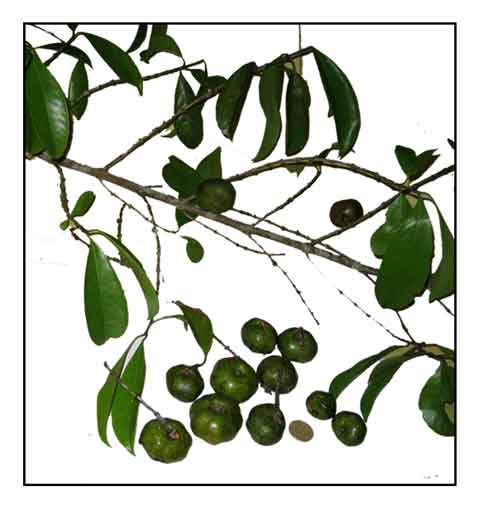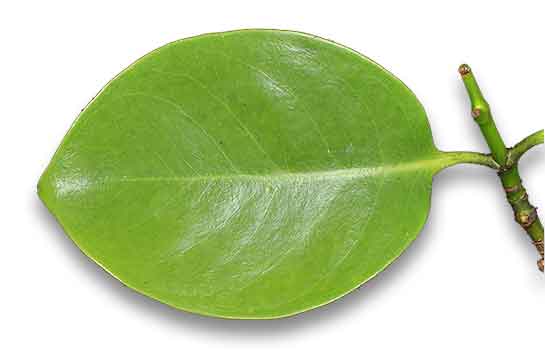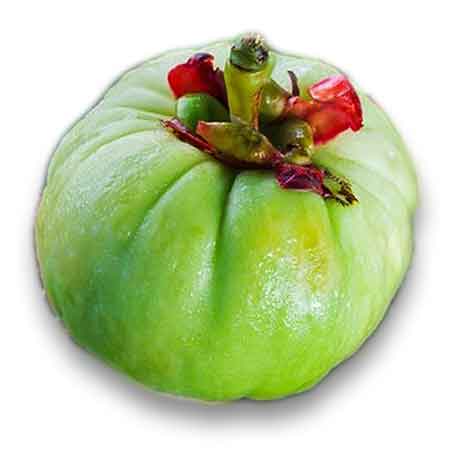 Gen info Gen info
- Garcinia binucao is a species of flowering plant in the Clusiaceae family.
- The first description of correct name of the species is attributed to French botanist Jacques Denys Choisy
in Description des guttiferes de I'lnde (1849) based on the basionym Cambogia binucao from Spanish friar and botanist Francisco Blanco in Flora de Filipinas in 1837. (12)
Botany
Binucao is a tree growing to a height of about 25 m with a diameter of about 40 cm. Bark is black. Leaves are opposite, shiny, and smooth. New leaves are reddish in color. Branches are pendulous. Flowers are small, reddish to creamy-white, borne in clusters. Fruits are subglobose, about 4 cm or more in diameter, yellowish when mature, with a firm outer covering, containing a very acid and juicy pulp with numerous seeds. (8)
Distribution
- Native to the Philippines.
- Widely distributed throughout Luzon and the Visayas regions.
- Scattered, second-storey trees of primary lowland and secondary forests. (8)
- Found in Sri Lanka and India.
 Constituents Constituents
- Study of G. binucao fruit yielded a mixture of ß-sitosterol (1) and stigmasterol (2) in a 3:2 ratio, and monounsaturated and saturated triglycerides (3). (4)
- Nutritional assessment of seed meal showed a protein content of 8.9 ± 0,59% dry basis. Solubility fractionation of seed meal yielded globulin and glutelin as the major seed proteins. The seed protein contained all essential amino acids with leucine as most abundant, tryptophan the least. Batuan seed proteins were mostly made up of acidic and hydrophobic amino acids with glutamic acid (2.67%) was highest. (see study below) (6)
- Phytochemical screening of fruits yielded phenolics, flavonoids, and tannins,
with absence of alkaloids, cardiac glycosides, terpenoids, and saponins. (9)
- Fruits yielded 84.1 ± 0.6% moisture, total phenolics 758 ± 22
mg GAE/ 100 g FM, total flavonoids 312 ± 9 mg CE/100 g FM, radical scavenging 479.7 ± 4.0 mg AWAC/100 g FM. ferric reducing power 121.1 ± 3.5 mg AAE/100 g FM, E. coli MIC 2 mg/GAE/mL, S. aureus MIC 1.33 mg/GAE/mL. (9)
Properties
- Studies have suggested neuroprotective, antidiabetic, antioxidant, biofuel potential, antibacterial, post-prandial glucose-lowering, nutrient, antihyperlipidemic properties.
Parts used
Fruits.
 Uses Uses
Edibility
-
Fruits are not cultivated; harvested from the wild, edible, although very acidic.
-
Fruit and leaves used as a souring agent in some provinces. (2)
- Fruits used for making candies, jam, ice creams, jelly, and dried prunes. (7)
Folkloric
- In the Cordilleras, used for suppressing "agas ti nginao" (conceiving mother's cravings). cough, flu, and arthritis. (2)
- Dried fruits used as treatment for dysentery. Fresh fruits used to help lower hypertension.
(7)
Others
- Wood: Used for light construction.
Studies
• Neuroprotective / Alcohol-Induced Neurotoxic Effects on Learning, Memory and Motor Functions / Leaves: Study evaluated crude methanolic leaf extracts in reducing deficits in learning, short-term memory and motor functions due to alcohol exposure using a Drosophila melanogaster model. Treatment with GB extract to flies chronically exposed to alcohol showed no significant reductions in motor, learning, and short-term memory functions. The functions were actually increased (p<0.05) in a dose dependent manner, suggesting not only neuroprotective effect, but also nootropic benefit. Mechanism of effect may be attributable to direct radical or oxidant scavenging properties of phytochemicals and modulation of signaling cascades which prevent neuronal apoptosis. (2)
• Hydroxycitric Acid / Anti-Obesity / Fruit: Hydoxycitric acid is a compound with anti-obesity property. Study reports on the most effective extraction method of hydroxycitric acid from batuan fruit. Results revealed G. binucao is a potential source of hydroxycitric acid . Water extraction method yielded 4.81 ± 0.12 g/100 g. Methanol and acetone extraction methods yielded lesser amounts. (3)
• Antibacterial Against Enteric Pathogens / Fruit: Study evaluated ethanolic leaf, seed, and fruit extracts of G. binucao for antibacterial activity by disc diffusion assay against selected gastrointestinal pathogens i.e. Salmonella sp., Shigella sp., and Vibrio cholerae. Tetracycline, ampicillin, and ciprofloxacin were used as controls. Only the fruit extract showed inhibitory activity towards Salmonella with ZOI of 10.22 mm, Shigella sp 12.50 mm and Vibrio cholera 13.30 mm. The fruit extract was the most efficient in inhibiting growth of the intestinal pathogens. Activity was attributed to phytochemical constituents such as terpenes and phenols. (5)
• Nutritional Potential / Seed Meal: Study evaluated the extraction and characterization of protein in batuan seeds. Nutritional assessment of seed meal showed a protein content of 8.9 ± 0,59% dry basis. Solubility fractionation of seed meal yielded globulin and glutelin as the major seed proteins. The seed protein contained all essential amino acids with leucine as most abundant, tryptophan the least. Batuan seed proteins were mostly made up of acidic and hydrophobic amino acids with glutamic acid (2.67%) was highest. Batuan seeds show promising potential as a source of valuable proteins and amino acids for use as food supplement/enhancing ingredient. (6)
• Biofuel Potential / Seed: Study seeks to evaluate the biofuel potential of Garcinia binucao seed and provides comparison between bioethanol and biodiesel. Among the batuan biomass, the seed is considered to have the highest potential for bioethanol production compared to peel and pulp. The seed endosperm has shown significantly higher total sugar (15.11 ± 1.01%) content than the peel (7.28 ±0.24%) and the pulp (3.32 ± 0.18$). The sugar increases from 3.94 ± 0.35% in the immature fruit to 10.18 ± 0.15% in the ripe fruit. Seed extract parameters of interest are appearance, acidity/alkalinity/ pHE, copper content, ethanol content, total acids and water content. (7)
• Physiochemical, Nutritional and Sensorial Properties: Study evaluated the physiochemical properties and nutritional profile of different parts and stages of fruit maturity of batuan. The pulp constituted the biggest part of the fruit; the immature one contained high moisture, which decreased with maturity. Ash, protein, sugar, protein, starch, total carbohydrates, total soluble solids and sodium were low in the fruits. Seeds contained high crude fat, crude protein and tannin. Fruits were high in vitamin C, potassium, phosphorus, calcium, magnesium, iron, and trace levels of zinc, copper,, and manganese. On sensory evaluation, fresh and dry, powdered fruits were comparable in color, mouth feel, taste, and general acceptability as souring agent for fish stew. The good physiochemical properties and nutrient contents are comparable or better than some conventional fruits used as souring agents. The powdered fruit has potential as a ready-to-use souring agent for domestic consumption. food industry, and other applications. (10)
• Antidiabetic / Enzyme Inhibition / Leaf and Fruit: Study evaluated the fruit and leaf phytochemicals, antioxidant activity, and α-amylase and α-glucosidase inhibitory activities. Results showed both leaf and fruit were rich in flavonoids, anthocyanins, and polyphenols. Leaf and fruit showed high antioxidant activity using DPPH free radical scavenging assay and FRAP assay. Very low IC50 values for α-amylase of 41.28 and 41.21 ppm and α-glucosidase of 53.28 and 50.20 ppm suggested effective enzyme inhibition. Results suggest both leaf and fruit have potential for lowering postprandial hyperglycemia. (11)
• Effect of Extract Supplementation on Lifespan of Common Housefly Exposed to Alcohol / Enzyme Inhibition / Leaf and Fruit: There is evidence to suggest that chronic alcohol abuse is associated with reduce life expectancy. Study evaluated the effects of G. binucao extract (GBE) supplementation on life span of common housefly Drosophila melanogaster in the presence or absence of chronic alcohol abuse. In D. melanogaster chronically exposed to alcohol, the longest mean lifespan was observed in flies treated with high-dose GBE (33.80 days). Results showed extract supplementation ameliorated the observed reduction in lifespan of D. melanogaster chronically exposed to alcohol. (13)
• Effect of Processing Methods on Hydroxycitric Acid Content / Fruits: The batuan fruit is a potential source of hydroxycitric acid (HCA), a compound with anti-obesity property. The fruit is commonly processed to extend shelf life and increase marketability and availability year round. Study evaluated the effect of various processing methods on HCA content of batuan. Fresh batuan fruits contain 4.81 g HCA/100 g pulp. Steam blanching reduced HCA content by 14.55-21.41%. Drying reduced it by 7.28-16.22%. Brine fermentation reduced it significantly by 39.08%. Freezing for 2 months reduced HCA by 13.30%. Results suggest freezing and drying at 60°C are the most effective methods for preserving HCA. (14)
• Potential Sources of Anti-Obesity Compound / Hydroxycitric Acid: Hydroxycitric acid (HCA), a derivative of citric acid, is a promising food component with reported anti-obesity properties. Study screened 20 underutilized fruits generally rich in citric acid by histochemical staining to detect the presence of HCA. Out of 20 local fruits, HCA was found only from Tamarindus indica (tamarind) flesh at 3.731 g HCA/100 g fresh weight and Garcinia binucao (batuan) flesh and seeds at 3.447 g HCA/100g fresh weight and 1.241 g HCA/100 g fresh weight, respectively. Results suggest potential of the fruits as functional ingredients in nutraceuticals and value-added products. (15)
• Antihyperlipidemic / Fruits: Study evaluated the antihyperlipidemic effect of Batuan fruits in Sprague Dawley rats using 95% ethanol as solvent. Atorvastatin was used as reference drug. A 50 mg/dL batuan extract significantly decreased the LDL-C, triglycerides, total cholesterol and significantly increased HDL count post treatment. (16)
Availability
- Wild-crafted.
- Products in the cybermarket.
|

![]()






